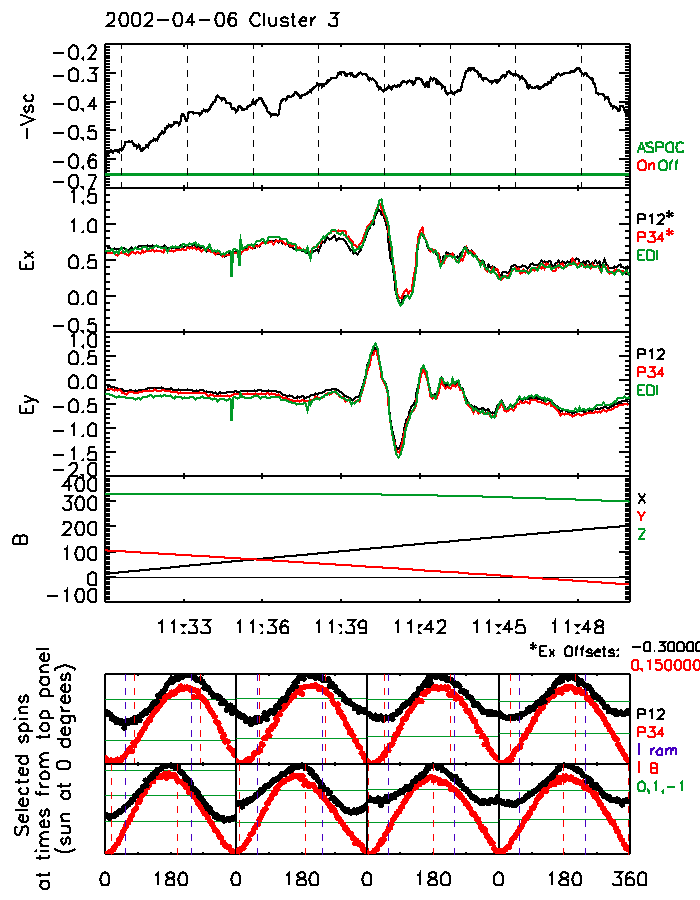
Online Help Pitfalls
Plasmasphere Related |
Region: PlasmasphereCaution level: Moderate |
| Problem Type |
Frequency of Occurence |
Ease of detection |
Remediable? |
Data Loss Severity |
|---|---|---|---|---|
| Probe saturation (partial or complete) |
Infrequent after 2001-06-01, Moderately frequent before. |
Moderate |
No |
Complete |
| Drifting offset in Ex, Ey between P12 and P34 |
Frequent |
Moderate |
Sometimes |
Minor |
Examples of good EFW data in the plasmasphere
 Data from the plasmasphere can often show remarkably good agreement with other instruments (EDI in this case). It is sometimes possible to track fields that are less than 0.1 mV/m More information on figure quantities is given here. |
Problem: Probe Saturation
| Example of the problem |
2002-04-18 0830C4, 2002-04-18 0839C4a (detail) 2001-03-16 2320C2 This is a smaller-amplitude amplitude problem that looks quite similar. Description of the plotted quantities. |
| Description of the problem |
When the plasma density is extremely high, one or more of the probes may suddenly shoot nonlinearly to a much lower potential.
Often, this results in the probes saturating at maximum negative potential,
-70V. This problem occurs only when the probe in question is pointing
sunward. At its maximum extent, the glitch occurs over about 90 degrees of phase, centred on the sunward direction. |
| How can it be detected? |
This can be clearly seen in either the single-probe
data or the double-probe (differenced) data. In the single probe data,
look for sudden nonlinear excursions to negative voltages when the probe
is in the sunward direction. In the double-probe data, look for huge
sunward fields that suddenly appear and disappear once or twice per spin. |
| How can it be corrected? |
This
probably cannot be corrected. It may be possible to remove the data
points from near the sunward direction, and at least recover the y component
of the field. This would be essentially the same technique as is applied
for wake removal in the solar wind. The few tests of this procedure
that have been performed have not, however, been encouraging. |
| Why does it occur? |
The exact reasons for this are not entirely known. What has been proposed is that in the dense plasmasphere, the plasma current becomes large enough that the photoemission "knee" on the I-V curve moves above the bias current. The probe potential then "shoots around the bend" in the IV curve to large negative voltages. What is not clear is why this is so sudden and so dramatic. Large plasma currents tend to smooth out the knee in the IV curve unless the temperature is extremely high (100s of eV). This should prevent the sudden "shooting around the bend" behaviour. Moreover, this problem has never been observed in any direction other than sunward, which is somewhat difficult to explain. The suddenness of the onset of this problem indicates that the IV curve must be either very flat from -10V out to -70V, or perhaps have a negative slope (negative resistance). How this is generated is uncertain, but may involve currents from the guards or pucks, or secondary emission (see e.g. Phys Rev Lett v82, no 3, 556-9,1999). |
| Other notes |
This does not seem to have occured since the bias currents were lowered on 2001-06-01. |
Problem: Drifting Offsets
| Example of the problem |
2001-07-04-1120C2 Note that the waves in the Ey direction are seen in both EFW and EDI. Description of the plotted quantities. |
| Description of the problem |
There is often an offset between the electric field measured from EFW and
EDI, and often between probe pair 1-2 and probe pair 3-4. This offset
is not strictly in the sunward direction (i.e. there can be an Ey offset). The offset drifts slowly with time. |
| How can it be detected? |
This
can only be detected by comparing to EDI (or perhaps CIS in the RPA mode),
although the difference between P12 and P34 estimates can be seen from spinfit
data. Caution is appropriate if the 2 probe pairs give different results. |
| How can it be corrected? |
Generally,
this is manifested as a slowly-drifting (<0.1 mV/min) offset. Note,
for example, that the waves seen in the example above are clearly
seen in both EDI and EFW. Often, this offset can simply be ignored unless an absolute value
is needed. Comparison of the fields derived
from P12 and from P34 may give an indication of the magnitude of the effect if EDI is not available. |
| Why does it occur? |
This is likely related to stray currents on an IV curve that has been "softened" by the high plasmapshere densities.
In this sense, it is a lesser manifestation of the saturation effect
(above). Note, for example, that the above example demonstrates non-sinusoidal
pulses in the sunward direction, similar to those seen in the saturation
cases. |
| Other notes |
Back to pitfalls and problems.